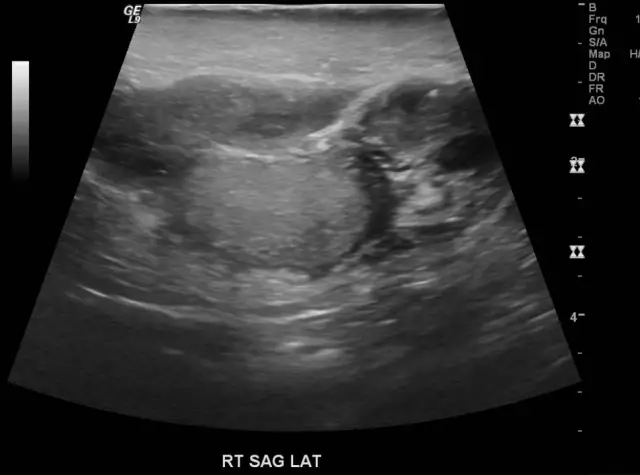- Author Curtis Blomfield [email protected].
- Public 2023-12-16 20:44.
- Last modified 2025-01-23 17:01.
Epididymitis is a disease that manifests itself in the form of an inflammatory process that occurs in the epididymis of the male testicle, namely in the tube that connects the gonad with the ducts that excrete the seed. Often the disease occurs due to infection of bacterial origin.

Symptoms of epididymitis are manifested in the form of sharp pain in the testicle, elevated body temperature (up to 40 ºС), hyperemia, swelling of the scrotum. With the disease, an effusion is formed in the affected area or simultaneous damage to the gonad and its appendage. It is for this reason that contouring in the scrotal cavity cannot be felt. Pain in epididymitis can spread to the groin and perineum, occasionally even to the lower back and sacrum, while intensifying at the moment of movement.
In the chronic form of the disease, during palpation of the epididymis, its seal is detected, occasionally an increase in volume, its clear delimited position in relation to the gonad, pain. This is how acute epididymitis manifests itself in the final stage. There are no symptoms,there is only a feeling of discomfort in the scrotum during periods of exacerbation of the disease. During this period, the ability of spermatozoa to fertilize decreases, and as a result, infertility may occur.

Symptoms of epididymitis can also manifest as enlarged lymph nodes in the groin area, discharge from the penis. In this case, the spermatic cord thickens, and the duct that removes spermatozoa increases in diameter.
In case of swelling and redness on one side of the scrotum, you should consult a doctor, as epididymitis can cause such manifestations. Diagnosis of the disease occurs in the following way:
1. An anamnesis is being collected. It also includes information about the patient's sexual life.
2. A laboratory study of urine analysis is performed. This detects the presence of sexually transmitted diseases and infections present in the urethra. Also, by analysis of urine and culture, the sensitivity of microorganisms is determined and inflammation of the bladder is diagnosed.

3. The prostate is examined. To do this, a swab is taken from the urethra to detect the presence of bacteria in it.
4. A blood test (general) is being studied. In this case, a high level of leukocytes may indicate the presence of an infectious infection.
5. Doppler ultrasound is performed and the affected testicle is scanned. These methods help to distinguish the symptoms of epididymitis fromsigns of other diseases similar in manifestation (hernia, dropsy, cysts).
6. Testing for gonorrhea and chlamydia is underway.
Using all of these techniques in combination is necessary to prevent the development of complications in case of an incorrect diagnosis.
Often, infections that affect the male gonads are transmitted through anal sex during same-sex contact. Even if only one sexual partner has symptoms of epididymitis, both partners should be tested.






